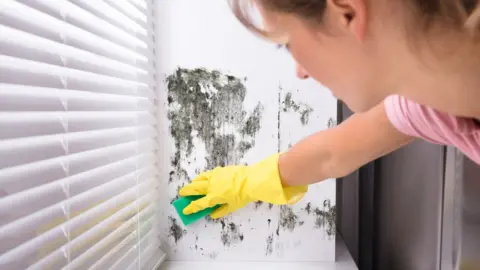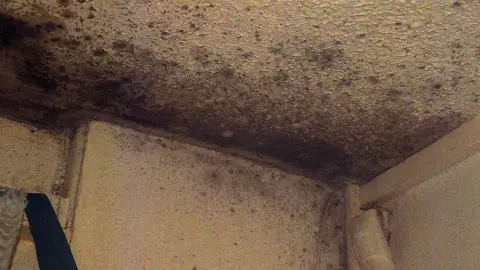Black mould: How dangerous is it in the home and how can it be treated?
 Getty Images
Getty ImagesLandlords for social housing in England will have to fix damp and mouldy properties more quickly from October, the government has announced.
The rules will eventually cover private landlords as well.
Campaigners called for stricter rules after two-year-old Awaab Ishak died because of mould at his Rochdale home in 2020.
What is black mould?
Mould - sometimes referred to by the American spelling mold - is a microscopic fungus that grows in damp places.
Mould spores are found everywhere, and are released in their thousands into the atmosphere.
Signs of mould at home include fuzzy black, white or green patches on the walls, and a damp and musty smell.
How does black mould affect your health?
People living with mould are more likely to suffer from respiratory illnesses, infections, allergies or asthma.
Inhaling or touching the spores that mould releases into the air can cause an allergic reaction, such as sneezing, a runny nose, red eyes and a skin rash.
Mould can also trigger asthma attacks and cause coughing, wheezing and breathlessness.
 Rochdale Coroners Office
Rochdale Coroners OfficeThe NHS in England spends an estimated £1.4bn every year treating illnesses associated with living in cold or damp housing, according to a 2021 report from building research body BRE.
Those more at risk from mould include the elderly, children and babies, as well as people with existing respiratory illnesses and some skin problems.
What causes mould in houses and how do you remove it?
Condensation is the leading cause of mould in homes across the UK.
It most commonly occurs in parts of the home where there are high moisture levels, such as bathrooms and kitchens.
When air cools, water vapour forms into water droplets as it comes into contact with cold surfaces.
These surfaces can include uninsulated external walls or windows.
If left untreated, the surface can become damp and create the conditions for mould to grow.
Older and poorly insulated properties are more prone to this.
Mould can also be caused by daily tasks which create excess moisture such as showering, cooking and drying washing indoors.
Taking shorter showers and wiping down surfaces afterwards can help, as can improving ventilation and opening windows or using an extractor fan when cooking.
It is also important to check for leaky pipes or gutters which can make the problem worse.
Who was Awaab Ishak?
 Family handout
Family handoutIn December 2020, two-year-old Awaab Ishak died after prolonged exposure to mould in his home.
He lived in a one-bedroom flat in Rochdale with his father Faisal Abdullah and Faisal's wife Aisha Amin.
Mr Abdullah reported the mould to his housing association, Rochdale Boroughwide Housing (RBH), in 2017, but was told to paint over it.
Awaab was taken to Rochdale Urgent Care Centre on 19 December that year with shortness of breath, and died a few days later.
What is Awaab's law and what will it mean for landlords?
All landlords - private and social - already have a duty to keep their homes fit for human habitation. But after Awaab Ishak's death, campaigners called for stricter measures.
Awaab's law was first passed in July 2023 under the previous Conservative government, but had not taken effect by the time of the 2024 general election.
Labour has said that from October 2025, the rules will apply to social landlords - generally local councils or housing associations.
These landlords will have to address damp and mould hazards that pose a significant risk of harm to tenants, within fixed timescales.
From the same point, they will also have to address all emergency repairs - whether related to damp and mould or not - within 24 hours.
New rules setting a timeframe for dealing with non-emergency repairs such as excess cold and heat, structural collapse, fire, electrical faults and hygiene issues will take effect in 2026. More hazards will be added in 2027.
Landlords who fail to act can be taken to court and ordered to pay compensation.
The Housing charity Shelter criticised the government's decision to phase in the new legislation. It said it leaves social housing tenants at risk from poor quality accommodation.
The government's Renters' Rights Bill, which is currently making its way through Parliament, will extend the new rules to cover private landlords.
Ministers previously said they hoped the bill would be passed by summer 2025.
